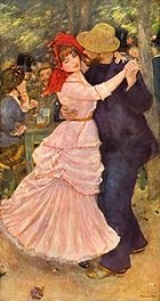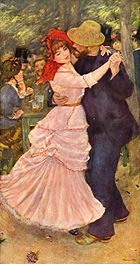
Closed position
Encyclopedia

Partner dance
Partner dances are dances whose basic choreography involves coordinated dancing of two partners, as opposed to individuals dancing alone or individually in a non-coordinated manner, and as opposed to groups of people dancing simultaneously in a coordinated manner.In the year 1023 the German poet...
, closed position is a category of positions in which partners hold each other while facing at least approximately toward each other.
Closed positions employ either body contact
Body contact (dance)
Body contact is a style of closed position in partner dancing.In some partner dances, the connection between the lead and follow is made by direct body contact, instead of a more open frame made with the arms...
or body support, that is, holding each other is not limited to handhold. If the partners are comfortable with each other and the dance style allows it, body contact increases the connection
Connection (dance)
Connection is essential to all partner dancing and is the primary means to communicate synchronized dance movement between the lead and follow. It is especially important in Argentine Tango, Lindy Hop, Balboa, East Coast Swing, West Coast Swing, Salsa, Contra dance, Modern Jive and other styles of...
between the partners. Some dances, such as Balboa
Balboa (dance)
Balboa today is commonly used both as a term to describe a fusion of dances that originated in Southern California during the 1920s and 1930s, and also referring to a specific dance from that era that was the original Balboa .The original Balboa dance is a form of swing dance that started as early...
and Collegiate Shag
Collegiate shag
The Collegiate Shag is a partner dance done primarily to upper tempo jazz music . It belongs to the swing family of American vernacular dances that arose in the 1920s, 30s, and 40s.-Name:...
are only done in body contact
Body contact (dance)
Body contact is a style of closed position in partner dancing.In some partner dances, the connection between the lead and follow is made by direct body contact, instead of a more open frame made with the arms...
.
The most commonly used kind of closed position comes from the waltz
Waltz
The waltz is a ballroom and folk dance in time, performed primarily in closed position.- History :There are several references to a sliding or gliding dance,- a waltz, from the 16th century including the representations of the printer H.S. Beheim...
, and is very commonly used in ballroom dance
Ballroom dance
Ballroom dance refers to a set of partner dances, which are enjoyed both socially and competitively around the world. Because of its performance and entertainment aspects, ballroom dance is also widely enjoyed on stage, film, and television....
. The leader's right hand is on the follower's back (or, rarely, on the left upper arm near the shoulder); its exact placement on the back ranges from the waist to the left shoulder blade. The follower's left hand is on the leader's right shoulder, or the upper arm near the shoulder. The other two hands are clasped together at or near chest or shoulder height.
Unlike the ballroom style, in social fast turning (or Viennese-style tempos) waltz, the follower's left hand usually is completely around the leader's right shoulder in a firm mutually supporting close or contact embrace. Each partner alternately but smoothly assists in the half turn with body leads while continuously right turning in line of direction in a "V" position. A similar close embrace position but with both hands around each other can be seen in smooth turning polka and other folk dances.
Some specific varieties of this kind of closed position are used in specific categories of ballroom dance. For instance, in the American tradition and the older European traditions, the joined hands are usually held lower than the shoulder, with the elbows low and often sharply bent. In the international standard ballroom dances the joined hands are held at or just above shoulder height, with the arms outstretched and the elbows bent at obtuse angles. In the latter style the leader's right hand stays on the left side of the follower's back and (except in the tango) is placed on the shoulder blade, while the follower's left hand is placed on the leader's right upper arm (or, in the tango, underneath the upper arm).
Many other kinds of closed positions are used in folk dance
Folk dance
The term folk dance describes dances that share some or all of the following attributes:*They are dances performed at social functions by people with little or no professional training, often to traditional music or music based on traditional music....
. In closed shoulder-waist position the leader holds the follower's waist with both hands, while the follower places both hands on the leader's shoulders. In Scandinavian folk dance (e.g. the polska
Polska (dance)
The polska is a family of music and dance forms shared by the Nordic countries: called polsk in Denmark, polska in Sweden and Finland and by several names in Norway in different regions and/or for different variants - including pols, rundom, springleik, and springar...
, pols
Pols
The pols is a Norwegian folk dance, a fast version of the Nordic polska....
, and hambo
Hambo
The hambo is a traditional dance that originated in Sweden in the late 19th and early 20th centuries. It is a couple dance in ¾ time, danced to music played with a strong accent on the first beat and a tempo that varies from moderate to fast...
) there are variations on shoulder-waist position in which the leader's left hand is on the follower's shoulder, upper arm, or elbow, and in the latter case the follower's right arm is outstretched with the hand just above the leader's sharply bent elbow.
The lavolta
Lavolta
The volta is an anglicised name for a Renaissance dance for couples from the later Renaissance. This dance was associated with the galliard and done to the same kind of music. Its main figure consisted of a turn and lift in a sort of closed position, which could be done either to the right or to...
, one of the more famous Renaissance dance
Renaissance dance
Renaissance dances belong to the broad group of historical dances.During the Renaissance period, there was a distinction between country dances and court dances. Court dances required the dancers to have been trained and were often for display and entertainment, whereas country dances could be...
s, used a distinctive kind of closed position in which the follower faced to one side from the leader and put the near hand on top of the leader's shoulder, while the leader used both hands to hold the follower under the busk
Busk
A busk is the rigid element of a corset placed at the centre front.In stays, the corsets worn between the fifteenth and eighteenth centuries, the busk was intended to keep the front of the corset straight and upright. It was made of wood, ivory, or bone slipped into a pocket and tied in place with...
.
See also
- Open positionOpen positionIn partner dancing, open position refers to positions in which partners are connected primarily at the hands as opposed to closer body contact, as in closed position. The connection is through the hands, wrists, and fingers, and relies heavily on frame and the compression and tension of both...
- Close embraceClose embraceIn partner dances, close embrace is a type of closed position where the leader and follower stand facing each other chest-to-chest in full or partiall body contact. The dancers usually stand offset from one another, such that each has his or her right toe in between the toes of his or her partner...
- FrameFrame (dance)Frame is the body shape maintained by dancers during partner dancing. Specifically, frame refers to the shape of the upper body of the dancers relative to the rest of the dancer's body and the body of the dancer's partner....
- ConnectionConnection (dance)Connection is essential to all partner dancing and is the primary means to communicate synchronized dance movement between the lead and follow. It is especially important in Argentine Tango, Lindy Hop, Balboa, East Coast Swing, West Coast Swing, Salsa, Contra dance, Modern Jive and other styles of...
- Body contactBody contact (dance)Body contact is a style of closed position in partner dancing.In some partner dances, the connection between the lead and follow is made by direct body contact, instead of a more open frame made with the arms...
- Ballroom danceBallroom danceBallroom dance refers to a set of partner dances, which are enjoyed both socially and competitively around the world. Because of its performance and entertainment aspects, ballroom dance is also widely enjoyed on stage, film, and television....
for a list of partner dancePartner dancePartner dances are dances whose basic choreography involves coordinated dancing of two partners, as opposed to individuals dancing alone or individually in a non-coordinated manner, and as opposed to groups of people dancing simultaneously in a coordinated manner.In the year 1023 the German poet...
s, including non-ballroom styles.

